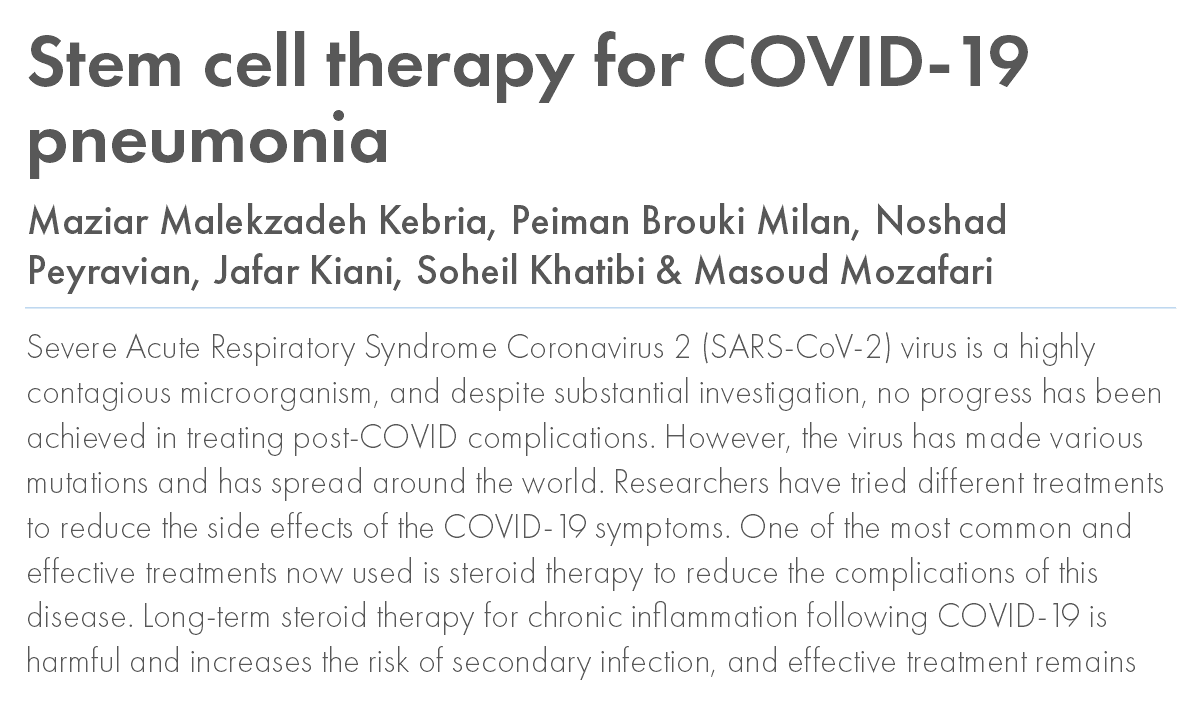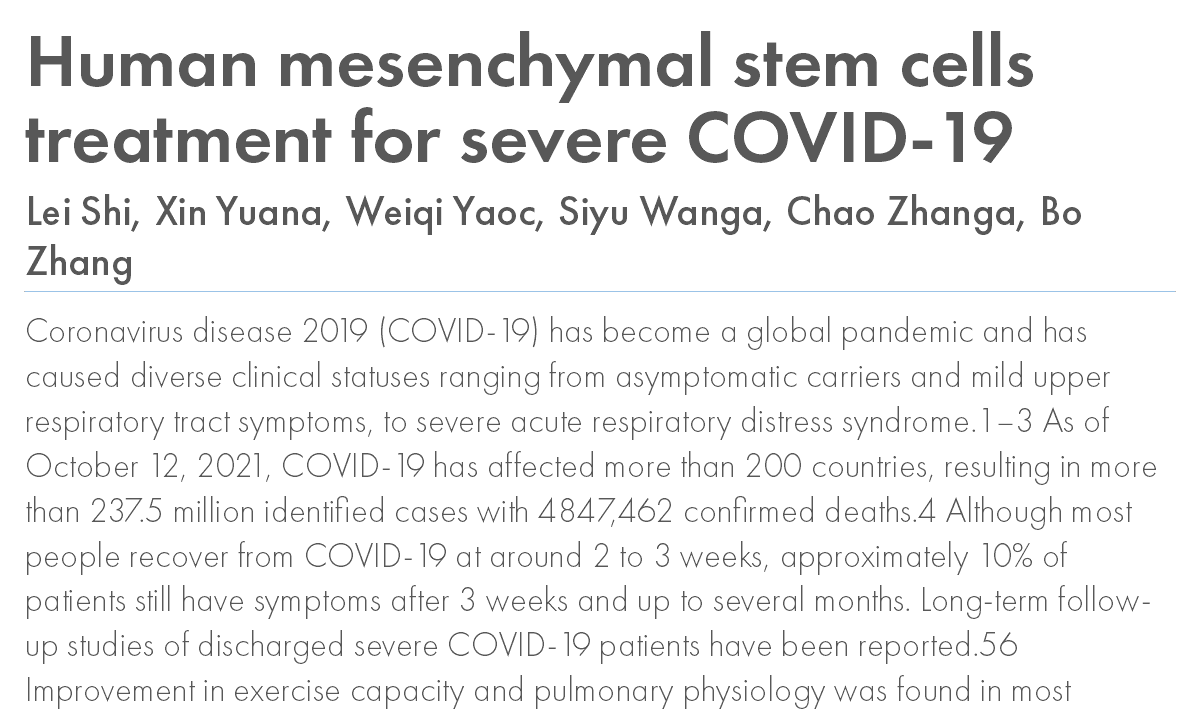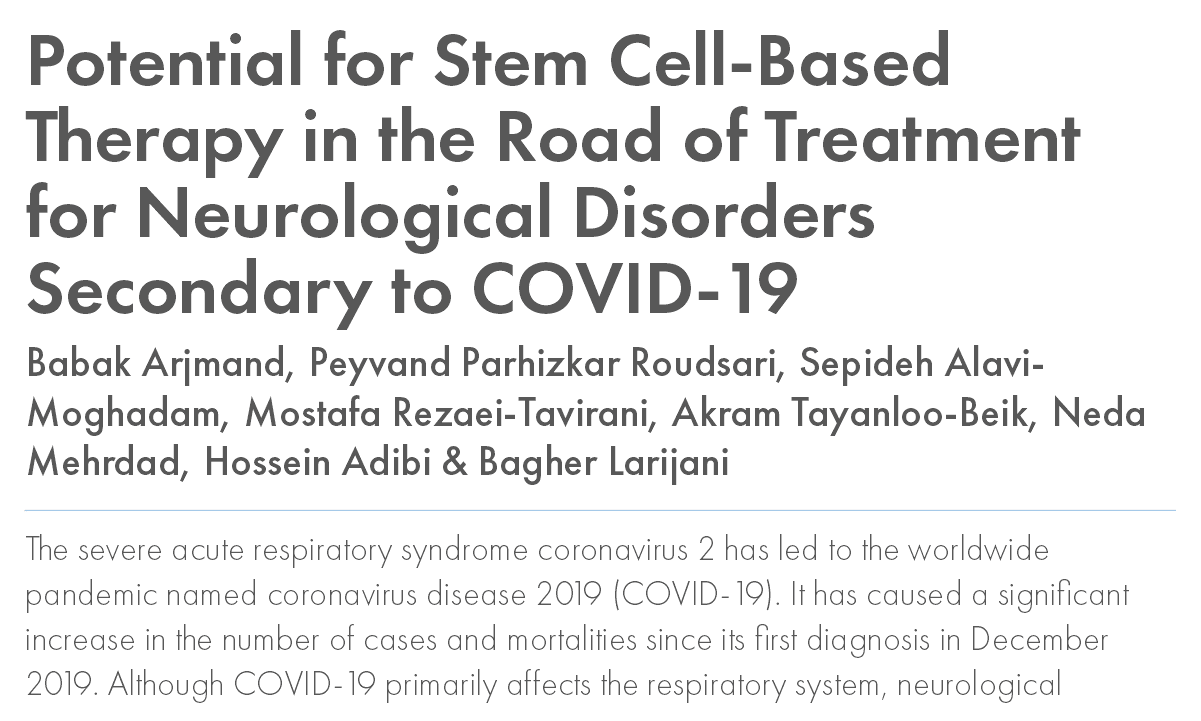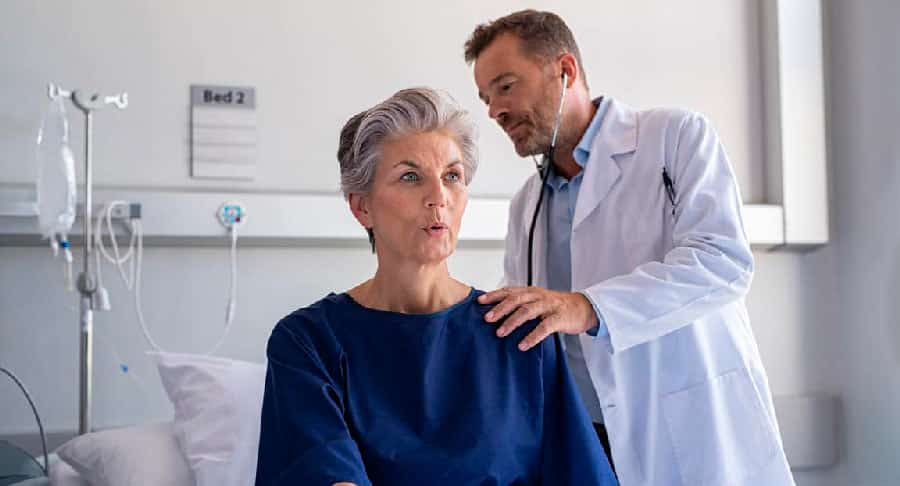U-MSC for Chronic Lung Disease (COPD)
Regenerative Medicine Treatment for Respiratory Care
Unlocking the therapeutic power of stem cells and exosomes to enhance quality of life for those with Pulmonary disorders.
Addressing Inflammatory Mechanisms of Chronic Pulmonary Lung Disease
U-MSC and exosome therapies utilize the regenerative capabilities of umbilical cord-derived stem cells. These cells have unique properties that enable differentiation and potential repair of damaged tissues, including those in the respiratory system – a critical benefit for patients with chronic pulmonary diseases such as COPD.
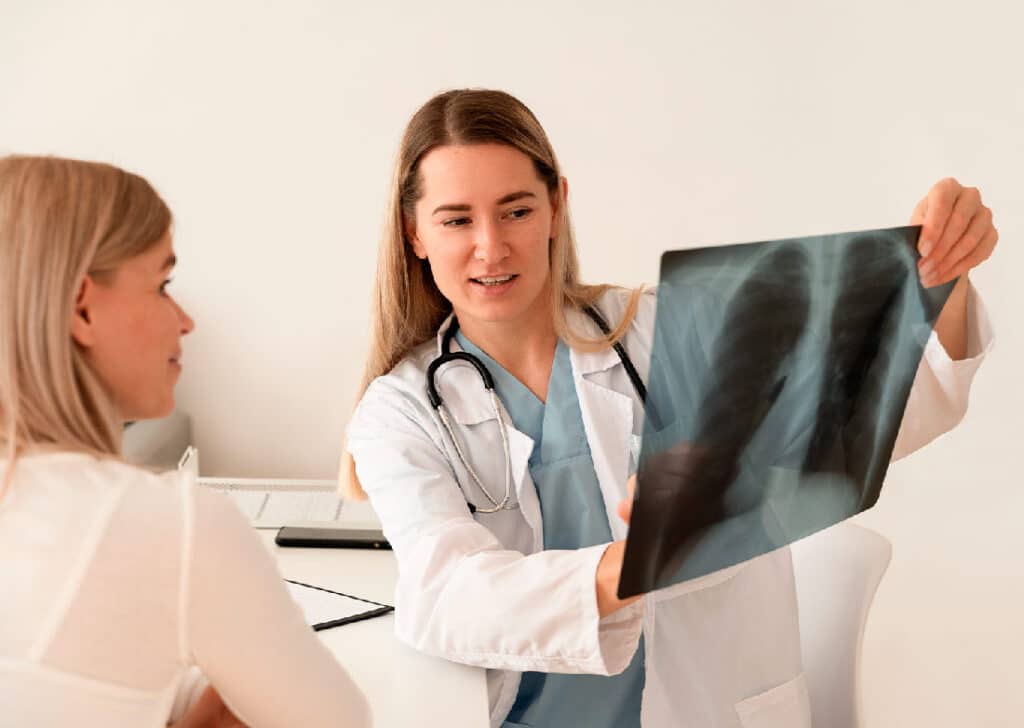
A multifaceted approach to alleviating COPD symptoms
Scientific research indicates that the synergistic effects of U-MSC and exosome therapies present a promising therapeutic strategy, specifically addressing the inflammatory components of chronic pulmonary diseases.
Anti-inflammatory Effects
U-MSCs secrete anti-inflammatory factors that can modulate the immune system, potentially reducing lung inflammation in conditions like COPD and asthma to alleviate symptoms and slow disease progression.
Immunomodulation
COPD and asthma involve immune dysregulation; U-MSCs, with their immunomodulatory properties, may help restore balance and reduce excessive immune responses in these conditions.
Protection Against Fibrosis
Fibrosis, the excessive buildup of connective tissue, often results from chronic inflammation and tissue damage, particularly in COPD. U-MSCs have shown potential to reduce fibrosis, helping to preserve lung function.
Bronchial Relaxation
Clinical evidence suggests that factors released by U-MSCs may help relax bronchial muscles, potentially alleviating bronchoconstriction (airway narrowing) seen in asthma.
Treatments rooted in scientific research
Stem cells possess a natural ability to repair damaged tissues, offering the potential to rejuvenate lung function and airways.
Utilizing the body’s innate systems, exosomes modulate immune responses to target inflammation reduction and promote healing.
U-MSC
U-MSCs are multipotent cells that can differentiate into a variety of cell types, making them highly valuable in regenerative treatments. This regenerative power makes them ideal for treating joint pain, as they help regenerate cartilage and other critical tissues.
U-MSC Derived Exosomes
Exosomes, tiny vesicles released by U-MSCs, play a crucial role in cell communication and tissue healing. These exosomes carry signals that help reduce inflammation and promote tissue repair, making them essential in restoring joint function.
Kebria, Maziar Malekzadeh; Milan, Peiman Brouki; Peyravian, Noshad; Kiani, Jafar; Khatibi, Soheil; Mozafari, Masoud
Stem cell therapy for COVID-19 pneumonia Journal Article
In: 2022.
@article{nokey,
title = {Stem cell therapy for COVID-19 pneumonia},
author = {Maziar Malekzadeh Kebria and Peiman Brouki Milan and Noshad Peyravian and Jafar Kiani and Soheil Khatibi and Masoud Mozafari},
url = {https://link.springer.com/article/10.1186/s43556-021-00067-8},
year = {2022},
date = {2022-02-17},
urldate = {2022-02-17},
abstract = {Severe Acute Respiratory Syndrome Coronavirus 2 (SARS-CoV-2) virus is a highly contagious microorganism, and despite substantial investigation, no progress has been achieved in treating post-COVID complications. However, the virus has made various mutations and has spread around the world. Researchers have tried different treatments to reduce the side effects of the COVID-19 symptoms. One of the most common and effective treatments now used is steroid therapy to reduce the complications of this disease. Long-term steroid therapy for chronic inflammation following COVID-19 is harmful and increases the risk of secondary infection, and effective treatment remains challenging owing to fibrosis and severe inflammation and infection. Sometimes our immune system can severely damage ourselves in disease. In the past, many researchers have conducted various studies on the immunomodulatory properties of stem cells. This property of stem cells led them to modulate the immune system of autoimmune diseases like diabetes, multiple sclerosis, and Parkinson's. Because of their immunomodulatory properties, stem cell-based therapy employing mesenchymal or hematopoietic stem cells may be a viable alternative treatment option in some patients. By priming the immune system and providing cytokines, chemokines, and growth factors, stem cells can be employed to build a long-term regenerative and protective response. This review addresses the latest trends and rapid progress in stem cell treatment for Acute Respiratory Distress Syndrome (ARDS) following COVID-19.},
keywords = {},
pubstate = {published},
tppubtype = {article}
}
Shi, Lei; Yuan, Xin; Yao, Weiqi; Wang, Siyu; Zhang, Chao; Zhang, Bo; Song, Jinwen; Huang, Lei; Xu, Zhe
Human mesenchymal stem cells treatment for severe COVID-19 Journal Article
In: 2021.
@article{nokey,
title = {Human mesenchymal stem cells treatment for severe COVID-19},
author = {Lei Shi and Xin Yuan and Weiqi Yao and Siyu Wang and Chao Zhang and Bo Zhang and Jinwen Song and Lei Huang and Zhe Xu},
url = {https://www.thelancet.com/journals/ebiom/article/PIIS2352-3964(21)00583-1/fulltext},
year = {2021},
date = {2021-12-25},
abstract = {The long-term consequences of human umbilical cord-derived mesenchymal stem cell (UC-MSC) treatment for COVID-19 patients are yet to be reported. This study assessed the 1-year outcomes in patients with severe COVID-19, who were recruited in our previous UC-MSC clinical trial.
Methods
In this prospective, longitudinal, cohort study, 100 patients enrolled in our phase 2 trial were prospectively followed up at 3-month intervals for 1 year to evaluate the long-term safety and effectiveness of UC-MSC treatment. The primary endpoint was an altered proportion of whole-lung lesion volumes measured by high-resolution CT. Other imaging outcomes, 6 min walking distance (6-MWD), lung function, plasma biomarkers, and adverse events were also recorded and analyzed. This trial was registered with ClinicalTrials.gov (NCT04288102).
Findings
MSC administration improved in whole-lung lesion volume compared with the placebo with a difference of −10.8% (95% CI: −20.7%, −1.5%, p = 0.030) on day 10. MSC also reduced the proportion of solid component lesion volume compared with the placebo at each follow-up point. More interestingly, 17.9% (10/56) of patients in the MSC group had normal CT images at month 12, but none in the placebo group (p = 0.013). The incidence of symptoms was lower in the MSC group than in the placebo group at each follow-up time. Neutralizing antibodies were all positive, with a similar median inhibition rate (61.6% vs. 67.6%) in both groups at month 12. No difference in adverse events at the 1-year follow-up and tumor markers at month 12 were observed between the two groups.},
keywords = {},
pubstate = {published},
tppubtype = {article}
}
Methods
In this prospective, longitudinal, cohort study, 100 patients enrolled in our phase 2 trial were prospectively followed up at 3-month intervals for 1 year to evaluate the long-term safety and effectiveness of UC-MSC treatment. The primary endpoint was an altered proportion of whole-lung lesion volumes measured by high-resolution CT. Other imaging outcomes, 6 min walking distance (6-MWD), lung function, plasma biomarkers, and adverse events were also recorded and analyzed. This trial was registered with ClinicalTrials.gov (NCT04288102).
Findings
MSC administration improved in whole-lung lesion volume compared with the placebo with a difference of −10.8% (95% CI: −20.7%, −1.5%, p = 0.030) on day 10. MSC also reduced the proportion of solid component lesion volume compared with the placebo at each follow-up point. More interestingly, 17.9% (10/56) of patients in the MSC group had normal CT images at month 12, but none in the placebo group (p = 0.013). The incidence of symptoms was lower in the MSC group than in the placebo group at each follow-up time. Neutralizing antibodies were all positive, with a similar median inhibition rate (61.6% vs. 67.6%) in both groups at month 12. No difference in adverse events at the 1-year follow-up and tumor markers at month 12 were observed between the two groups.
Arjmand, Babak; Roudsari, Peyvand Parhizkar; Alavi-Moghadam, Sepideh; Rezaei-Tavirani, Mostafa; Tayanloo-Beik, Akram; Mehrdad, Neda; Adibi, Hossein; Larijani, Bagher
Potential for Stem Cell-Based Therapy in the Road of Treatment for Neurological Disorders Secondary to COVID-19 Journal Article
In: 2021.
@article{nokey,
title = {Potential for Stem Cell-Based Therapy in the Road of Treatment for Neurological Disorders Secondary to COVID-19},
author = {Babak Arjmand and Peyvand Parhizkar Roudsari and Sepideh Alavi-Moghadam and Mostafa Rezaei-Tavirani and Akram Tayanloo-Beik and Neda Mehrdad and Hossein Adibi and Bagher Larijani },
url = {https://link.springer.com/article/10.1007/s40883-021-00234-x},
year = {2021},
date = {2021-10-29},
abstract = {The severe acute respiratory syndrome coronavirus 2 has led to the worldwide pandemic named coronavirus disease 2019 (COVID-19). It has caused a significant increase in the number of cases and mortalities since its first diagnosis in December 2019. Although COVID-19 primarily affects the respiratory system, neurological involvement of the central and peripheral nervous system has been also reported. Herein, the higher risk of neurodegenerative diseases in COVID-19 patients in future is also imaginable. Neurological complications of COVID-19 infection are more commonly seen in severely ill individuals; but, earlier diagnosis and treatment can lead to better long-lasting results. In this respect, stem cell biotechnologies with considerable self-renewal and differentiation capacities have experienced great progress in the field of neurological disorders whether in finding out their underlying processes or proving them promising therapeutic approaches. Herein, many neurological disorders have been found to benefit from stem cell medicine strategies. Accordingly, in the present review, the authors are trying to discuss stem cell-based biotechnologies as promising therapeutic options for neurological disorders secondary to COVID-19 infection through reviewing neurological manifestations of COVID-19 and current stem cell-based biotechnologies for neurological disorders.},
keywords = {},
pubstate = {published},
tppubtype = {article}
}
Kebria, Maziar Malekzadeh; Milan, Peiman Brouki; Peyravian, Noshad; Kiani, Jafar; Khatibi, Soheil; Mozafari, Masoud
Stem cell therapy for COVID-19 pneumonia Journal Article
In: 2022.
@article{nokey,
title = {Stem cell therapy for COVID-19 pneumonia},
author = {Maziar Malekzadeh Kebria and Peiman Brouki Milan and Noshad Peyravian and Jafar Kiani and Soheil Khatibi and Masoud Mozafari},
url = {https://link.springer.com/article/10.1186/s43556-021-00067-8},
year = {2022},
date = {2022-02-17},
urldate = {2022-02-17},
abstract = {Severe Acute Respiratory Syndrome Coronavirus 2 (SARS-CoV-2) virus is a highly contagious microorganism, and despite substantial investigation, no progress has been achieved in treating post-COVID complications. However, the virus has made various mutations and has spread around the world. Researchers have tried different treatments to reduce the side effects of the COVID-19 symptoms. One of the most common and effective treatments now used is steroid therapy to reduce the complications of this disease. Long-term steroid therapy for chronic inflammation following COVID-19 is harmful and increases the risk of secondary infection, and effective treatment remains challenging owing to fibrosis and severe inflammation and infection. Sometimes our immune system can severely damage ourselves in disease. In the past, many researchers have conducted various studies on the immunomodulatory properties of stem cells. This property of stem cells led them to modulate the immune system of autoimmune diseases like diabetes, multiple sclerosis, and Parkinson's. Because of their immunomodulatory properties, stem cell-based therapy employing mesenchymal or hematopoietic stem cells may be a viable alternative treatment option in some patients. By priming the immune system and providing cytokines, chemokines, and growth factors, stem cells can be employed to build a long-term regenerative and protective response. This review addresses the latest trends and rapid progress in stem cell treatment for Acute Respiratory Distress Syndrome (ARDS) following COVID-19.},
keywords = {},
pubstate = {published},
tppubtype = {article}
}
Shi, Lei; Yuan, Xin; Yao, Weiqi; Wang, Siyu; Zhang, Chao; Zhang, Bo; Song, Jinwen; Huang, Lei; Xu, Zhe
Human mesenchymal stem cells treatment for severe COVID-19 Journal Article
In: 2021.
@article{nokey,
title = {Human mesenchymal stem cells treatment for severe COVID-19},
author = {Lei Shi and Xin Yuan and Weiqi Yao and Siyu Wang and Chao Zhang and Bo Zhang and Jinwen Song and Lei Huang and Zhe Xu},
url = {https://www.thelancet.com/journals/ebiom/article/PIIS2352-3964(21)00583-1/fulltext},
year = {2021},
date = {2021-12-25},
abstract = {The long-term consequences of human umbilical cord-derived mesenchymal stem cell (UC-MSC) treatment for COVID-19 patients are yet to be reported. This study assessed the 1-year outcomes in patients with severe COVID-19, who were recruited in our previous UC-MSC clinical trial.
Methods
In this prospective, longitudinal, cohort study, 100 patients enrolled in our phase 2 trial were prospectively followed up at 3-month intervals for 1 year to evaluate the long-term safety and effectiveness of UC-MSC treatment. The primary endpoint was an altered proportion of whole-lung lesion volumes measured by high-resolution CT. Other imaging outcomes, 6 min walking distance (6-MWD), lung function, plasma biomarkers, and adverse events were also recorded and analyzed. This trial was registered with ClinicalTrials.gov (NCT04288102).
Findings
MSC administration improved in whole-lung lesion volume compared with the placebo with a difference of −10.8% (95% CI: −20.7%, −1.5%, p = 0.030) on day 10. MSC also reduced the proportion of solid component lesion volume compared with the placebo at each follow-up point. More interestingly, 17.9% (10/56) of patients in the MSC group had normal CT images at month 12, but none in the placebo group (p = 0.013). The incidence of symptoms was lower in the MSC group than in the placebo group at each follow-up time. Neutralizing antibodies were all positive, with a similar median inhibition rate (61.6% vs. 67.6%) in both groups at month 12. No difference in adverse events at the 1-year follow-up and tumor markers at month 12 were observed between the two groups.},
keywords = {},
pubstate = {published},
tppubtype = {article}
}
Methods
In this prospective, longitudinal, cohort study, 100 patients enrolled in our phase 2 trial were prospectively followed up at 3-month intervals for 1 year to evaluate the long-term safety and effectiveness of UC-MSC treatment. The primary endpoint was an altered proportion of whole-lung lesion volumes measured by high-resolution CT. Other imaging outcomes, 6 min walking distance (6-MWD), lung function, plasma biomarkers, and adverse events were also recorded and analyzed. This trial was registered with ClinicalTrials.gov (NCT04288102).
Findings
MSC administration improved in whole-lung lesion volume compared with the placebo with a difference of −10.8% (95% CI: −20.7%, −1.5%, p = 0.030) on day 10. MSC also reduced the proportion of solid component lesion volume compared with the placebo at each follow-up point. More interestingly, 17.9% (10/56) of patients in the MSC group had normal CT images at month 12, but none in the placebo group (p = 0.013). The incidence of symptoms was lower in the MSC group than in the placebo group at each follow-up time. Neutralizing antibodies were all positive, with a similar median inhibition rate (61.6% vs. 67.6%) in both groups at month 12. No difference in adverse events at the 1-year follow-up and tumor markers at month 12 were observed between the two groups.
Arjmand, Babak; Roudsari, Peyvand Parhizkar; Alavi-Moghadam, Sepideh; Rezaei-Tavirani, Mostafa; Tayanloo-Beik, Akram; Mehrdad, Neda; Adibi, Hossein; Larijani, Bagher
Potential for Stem Cell-Based Therapy in the Road of Treatment for Neurological Disorders Secondary to COVID-19 Journal Article
In: 2021.
@article{nokey,
title = {Potential for Stem Cell-Based Therapy in the Road of Treatment for Neurological Disorders Secondary to COVID-19},
author = {Babak Arjmand and Peyvand Parhizkar Roudsari and Sepideh Alavi-Moghadam and Mostafa Rezaei-Tavirani and Akram Tayanloo-Beik and Neda Mehrdad and Hossein Adibi and Bagher Larijani },
url = {https://link.springer.com/article/10.1007/s40883-021-00234-x},
year = {2021},
date = {2021-10-29},
abstract = {The severe acute respiratory syndrome coronavirus 2 has led to the worldwide pandemic named coronavirus disease 2019 (COVID-19). It has caused a significant increase in the number of cases and mortalities since its first diagnosis in December 2019. Although COVID-19 primarily affects the respiratory system, neurological involvement of the central and peripheral nervous system has been also reported. Herein, the higher risk of neurodegenerative diseases in COVID-19 patients in future is also imaginable. Neurological complications of COVID-19 infection are more commonly seen in severely ill individuals; but, earlier diagnosis and treatment can lead to better long-lasting results. In this respect, stem cell biotechnologies with considerable self-renewal and differentiation capacities have experienced great progress in the field of neurological disorders whether in finding out their underlying processes or proving them promising therapeutic approaches. Herein, many neurological disorders have been found to benefit from stem cell medicine strategies. Accordingly, in the present review, the authors are trying to discuss stem cell-based biotechnologies as promising therapeutic options for neurological disorders secondary to COVID-19 infection through reviewing neurological manifestations of COVID-19 and current stem cell-based biotechnologies for neurological disorders.},
keywords = {},
pubstate = {published},
tppubtype = {article}
}
Complete the form to receive detailed information about regenerative medicine therapies for COPD
- Secure HIPAA Compliant
- 48 Hours Response
- No Obligations
GETTING STARTED
Start by filling out our Pre Screening Questionnaire and a member of our team will reach out to discuss your interest and answer any initial questions.
PATIENT INTAKE QUESTIONNAIRE
Please fill out the patient intake questionnaire. This information will help our team better understand your medical history and needs.
SCHEDULE A VIDEO CONSULTATION
Book a video consultation with our medical team. During this consultation, you may be asked to provide any relevant medical records or images for review.
Final Review
Our team will conduct a final review of your case, and we will outline the recommended next steps based on your consultation and submitted information.
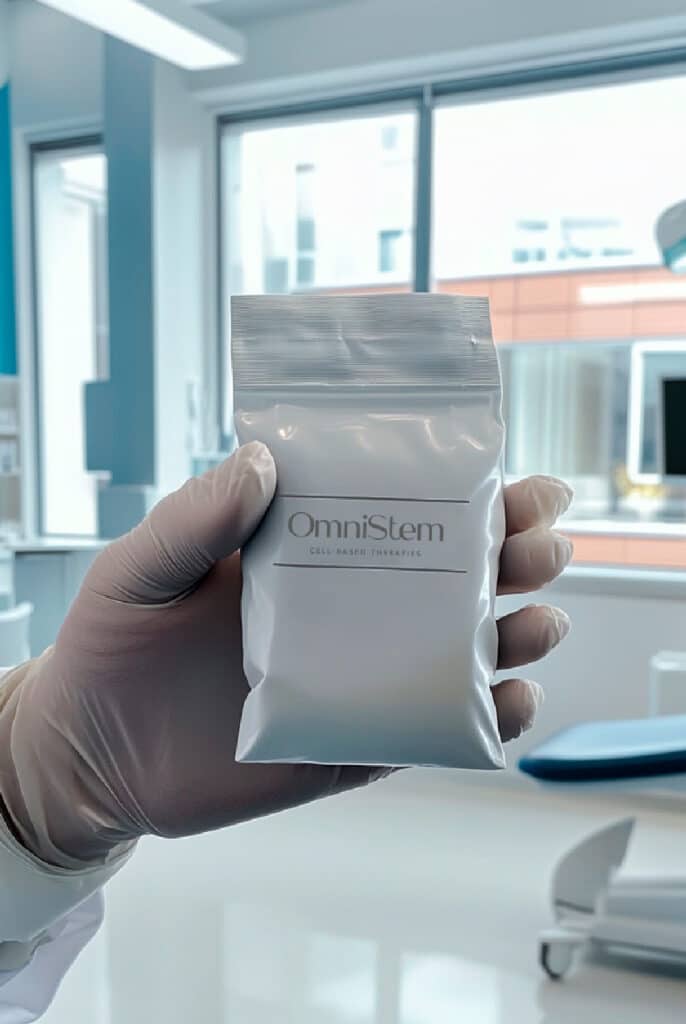
OmniStem Cell-based Therapies
Frequently Asked Questions
Please explore our Resource Center for helpful information. If you have any additional questions, feel free to contact our patient care team for assistance.
Umbilical cord mesenchymal stem cells (U-MSCs) are a type of adult stem cell found in Wharton’s jelly, a gelatinous substance within the umbilical cord. These cells have the ability to differentiate into various cell types, such as bone, cartilage, and fat cells, making them highly valuable for regenerative medicine and cell therapies.
Exosomes are microscopic, sac-like vesicles naturally released by cells, containing a rich payload of proteins, RNA, and other biomolecules essential for cellular communication and repair. Typically 30–200 nanometers in size, these extracellular vesicles play a pivotal role in maintaining and restoring cellular health.
At OmniStem, we harness the therapeutic potential of exosomes derived from umbilical cord mesenchymal stem cells (U-MSCs). These exosomes act as messengers, delivering regenerative signals to damaged tissues to support healing and reduce inflammation.
U-MSC stem cell treatments are considered specialized and are generally not covered by insurance plans.
U-MSC-derived allogenic stem cell therapies are currently not allowed in the U.S.
While mesenchymal stem cells (U-MSCs) have received FDA approval, the FDA does not permit the expansion of allogenic stem cells. As a result, patients undergoing these therapies in the U.S. typically receive a limited number of cells, which may reduce the potential benefits, including the use of U-MSC-derived exosomes.
At OmniStem, we use a safe and controlled laboratory process to expand these cells, enabling us to administer tens of millions of U-MSCs and U-MSC exosomes to our patients. This approach significantly enhances treatment outcomes.
This is a key reason many individuals travel to countries like Colombia, Panamá, Mexico, and the Dominican Republic to seek recognized providers of the most advanced regenerative medicine biologics available.
Our main facilities are located in the city of Pereira, in Colombia. We have specialized clinics and application centers for stem cell treatments that comply with all biosafety protocols and the highest safety standards. Pereira is the capital of the Colombian coffee region, one of the wonders of tourism in the country, and a World Heritage Site declared by UNESCO.

